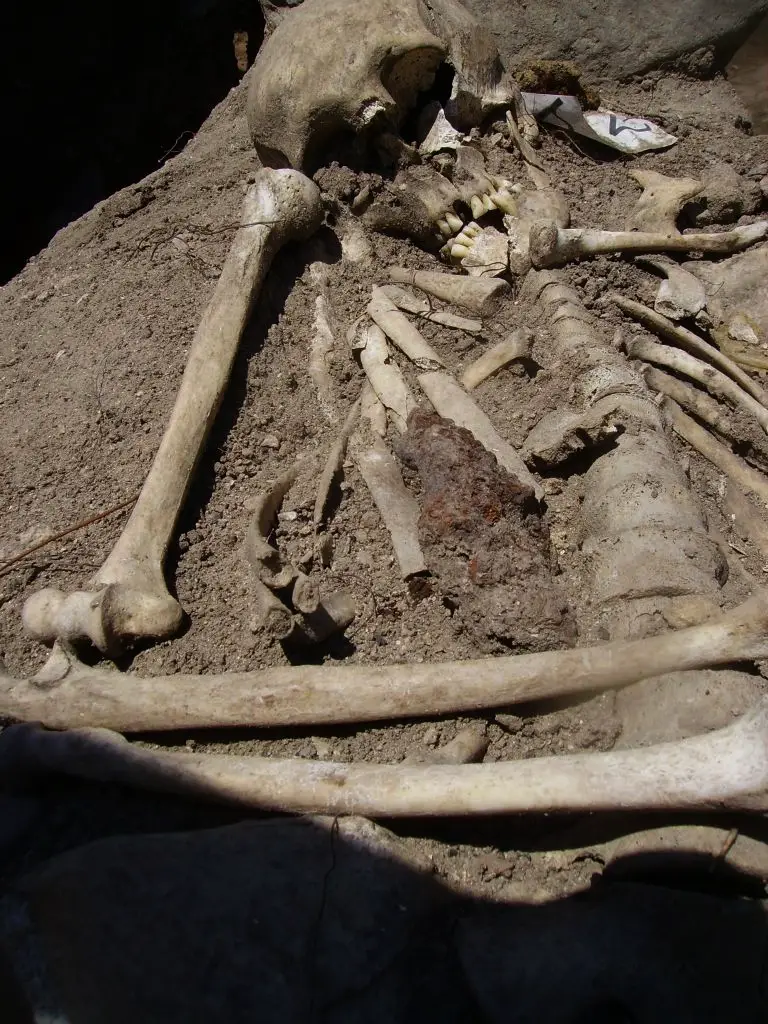The skeleton, pinned through the chest with an iron rod, at the excavation site in Sozopol, Bulgaria. Photograph: National History Museum of Bulgaria/EPA
Last weekend, Bulgarian archaeologists working near the Black Sea town of Sozopol unearthed centuries-old skeletons pinned down through their chests with iron rods. Interestingly, this technique was evidently used to “stop the dead from becoming vampires”: people who had been “unusual” in life (alcoholics, criminals and assorted outsiders) were automatically suspect, even before any vampiric assaults had actually occurred.
The Bulgarian finds were mere youngsters by comparison with the deviant burials unearthed in Mikulovice, in the Czech Republic, a few years ago. There, the bodies weighted down with rocks were thought to be around 5,000 years old.
In the age of modern “vampotainment” – with Johnny Depp recently offering yet another vampire who many women (and men) would die for – we might forget that vampires were not invented for fun. For most of history, vampirism was the subject of mind-shattering terror. During a vampire outbreak, everyone would routinely flee their houses and sleep together in one building. Meanwhile, there was the question of those who fell into a coma. In Greece, one family was so terrified that their comatose daughter risked becoming undead that they buried her alive, against the desperate pleas of the local doctor (secretly, he opened up her grave that night, only to have her die in his arms). In the same country, another luckless man woke from a coma at his own funeral, in his open coffin. Sadly, this was no cause for celebration. Traumatised by this vampiric being, the villagers stoned him to death.
These may look like classic examples of superstition triumphing over science. But modern science also helps us understand just how and why vampires could be overwhelmingly horrific. Try this bit of vampire forensics, written by a Cretan monk in 1888:
“The common practice of the vrykolakas [Greek vampires] is to seat themselves upon those who are asleep and by their enormous weight to cause an agonising sense of oppression.”
Sufferers felt they were being smothered or suffocated; and, though more or less conscious, they could neither move nor speak.
Sounds like a bit of a nightmare? It was – literally. Owen Davies explains that “sleep paralysis” is relatively common, occurring in 20-45% of people. More rarely (about 5-20% of people), sleep paralysis can be combined with a nightmare. This is no mere bad dream. It might include hallucinations and a powerful sense of an alien presence in your room. One soldier, who had fought for 13 consecutive months in Korea, stated of his single nightmare attack: “Never, before or since, have I experienced the fear of that night.”
If Robert Pattinson sat on Kristen Stewart’s chest in the middle of the night, we can well imagine the censors would be pretty terrified – at least about losing their PG certification. But there’s another problem. If you sent Pattinson or Lugosi trick-or-treating in real vampire country, the locals wouldn’t actually recognise them as a vampire. Indeed, if a caped, lean, pale and haughty aristocrat appeared in your humble village one evening, there was only one reason to be frightened of him: namely, because someone so rarefied-looking was probably your blood-sucking landlord. In reality, the undecayed corpse found in the grave would often be bloated (not thin), and conspicuously reddened (not pale) – as you’d naturally expect from a creature feeding on blood. Sharp teeth were far from essential, and if they were found, were merely further evidence that the vampire was undead: it was not only undecayed, but still growing. Oh – and, for the dress code? No dinner jacket required. A humble peasant shroud would do – ideally a little torn and frayed, to indicate that the vampire had been chewing hungrily on it in its grave.

The real vampires died out only fairly recently: the Greek stoning, for example, occurred about 1930. Here and there, they may still live on as I write. In November 2003, Stephenie Meyer signed the contract for Twilight. A few weeks after this, in January 2004, the Romanian villagers of Marotinul-de-Sus smelt a vampire when a woman fell ill. The culprit was identified as the recently deceased Petre Toma. Around midnight, six men disinterred his body, split open the ribcage, and removed his heart. This was burned, and the ashes were given to the sick woman to drink in water (to escape a vampire, it’s sometimes necessary to turn cannibal). Although the Romanians called Toma a strigoi (poltergeist), this was a typical folk way of explaining and fighting sickness. The vampire, not germs, was to blame.
To those who are a little disorientated by vampires’ cavalier attitude to Hollywood stereotypes, I can offer one minor consolation: Marotinul-de-Sus is in Transylvania. At least history got that bit right.
• Follow Comment is Free on Twitter @commentisfree
guardian.co.uk © Guardian News & Media Limited 2010




